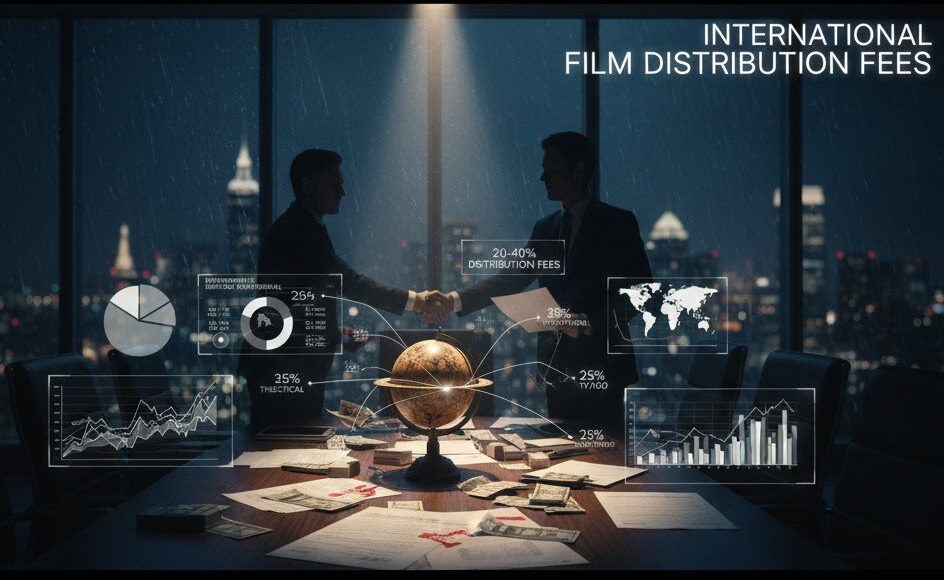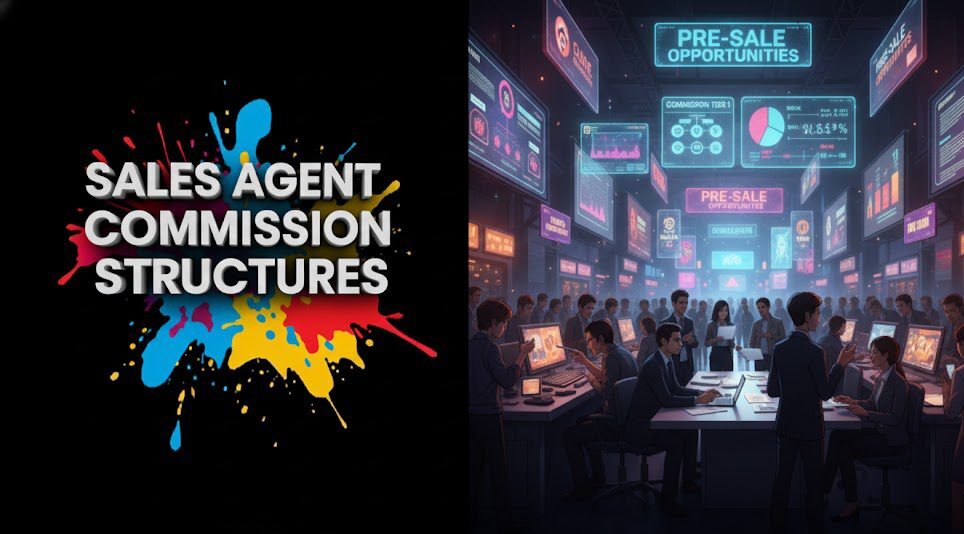Introduction
So, you’ve poured your heart and soul into making a movie. The script was perfect, the actors were amazing, and the final cut looks incredible. But now what? How does your film get from your hard drive to audiences around the world? That’s where understanding what is film sales and distribution comes in.
It might sound complicated, but this guide is here to break down the basics for independent filmmakers, film students, and new producers. We’ll explain the movie sales process, look at how film distribution works, and clarify the important role of a film sales agent. Getting your movie seen is the ultimate goal, and this is your first step to figuring out how!
Table of content
- Introduction
- Key-Takeaways
- Defining Film Sales: What Are You Actually Selling?
- Demystifying Film Distribution: How Movies Reach Audiences
- Key Players in the Film Sales and Distribution Ecosystem
- The Independent Film Perspective on Sales and Distribution
- Getting Started: First Steps for Filmmakers
- Conclusion
- FAQs
Key Takeaways
| Concept | Brief Explanation |
|---|---|
| Film Sales Defined | The process of selling the rights to exhibit a film to various entities (distributors, broadcasters, streaming platforms). |
| Film Distribution Defined | The process of making a film available to the audience through various channels (theaters, VOD, TV, etc.). |
| Core Goal | To maximize a film’s reach to its target audience and generate revenue. |
| Key Players | Filmmakers/Producers, Sales Agents, Distributors (like Focus Features or Searchlight Pictures), Exhibitors, Platforms. |
| Importance for Indies | Crucial for independent filmmakers to understand this landscape to get their work seen and potentially recoup investments. This is central to independent film distribution explained. |
Want to Understand the Movie Sales Process Better?

Defining Film Sales: What Are You Actually Selling?

When we talk about what is film sales and distribution, the “sales” part often comes first. But what exactly are you selling? You’re not usually selling the entire ownership (copyright) of your movie. Instead, you’re selling or licensing specific rights to your film. Think of it like renting out different rooms in your house (your film) to different people (buyers) for specific purposes and times. The movie sales process is all about finding the right “tenants” for these rights. Companies like Pathe or Constantin Film AG are major players in acquiring these rights for various markets.
Understanding film rights: What gets licensed or sold?
The rights you license can be broken down in many ways. These are the building blocks of any film sale deal:
- Territory: This defines the geographic area where the buyer can exhibit your film (e.g., North America, Germany, Latin America, Worldwide).
- Term: This is the length of time the buyer has the rights (e.g., 5 years, 10 years, in perpetuity for some specific rights).
- Media: This specifies the platforms or formats the buyer can use. Common media rights include:
- Theatrical (cinema release)
- Video-on-Demand (VOD – can be SVOD like Netflix, AVOD like Tubi, or TVOD like iTunes)
- Television (Pay TV, Free TV, Cable)
- Inflight (for airplanes)
- Educational
- Home Video (DVD/Blu-ray – less common now but still exists)
- Exclusivity: Are the rights exclusive to that buyer in that territory for that media, or can you sell similar rights to someone else? Usually, key rights are exclusive.
Understanding these distinctions is crucial when you’re navigating the film distribution basics and negotiating deals.
The concept of “windows” in film sales.
“Windows” refer to the sequence and timing of when a film becomes available on different platforms or media. Traditionally, a film might first have a theatrical window, then a home video/TVOD window, then a Pay TV window, and finally a Free TV or SVOD library window. These windows are strategically designed to maximize revenue from each platform before moving to the next. However, with the rise of streaming, these windows are becoming more flexible and sometimes compressed, or even bypassed (e.g., a straight-to-streaming release). Understanding windowing is a core part of figuring out how film distribution works in the modern era.
| Right Category | Example | Importance |
|---|---|---|
| Territory | “United States and Canada” | Defines geographic market for the buyer. |
| Term | “7 years from delivery” | Specifies duration of the license. |
| Media | “All SVOD rights” | Determines which platforms the film can be on. |
| Exclusivity | “Exclusive theatrical rights” | Prevents others from showing it in cinemas in that territory. |
This structured approach to selling rights helps maximize a film’s earning potential globally. Many distributors, such as Paramount Global Content Distribution, manage vast catalogs based on these detailed rights.
Demystifying Film Distribution: How Movies Reach Audiences
So, you’ve made a sale (or several sales for different rights). Great! But what is film sales and distribution without the “distribution” part? Distribution is the actual process of getting your movie out there for people to watch. It’s the bridge between the deal being signed and an audience member pressing “play” or buying a cinema ticket. The methods and channels for film distribution basics are more varied today than ever before, involving companies big and small, from global players like Nordisk Film in Scandinavia to regional specialists.
The journey of a film from completion to the viewer.
The distribution journey can look something like this, though it varies hugely:
- Film Completion & Delivery: The filmmaker provides the distributor with all the required materials (the “deliverables” – master files, artwork, legal documents).
- Marketing & Promotion Strategy: The distributor (often in consultation with the filmmaker) plans and executes a marketing campaign. This could involve trailers, posters, press, advertising, social media.
- Securing Exhibition:
- For Theatrical: The distributor books the film into cinemas.
- For Streaming/VOD: The distributor ensures the film is ingested and listed on the platform. This is where a company like Cineverse might play a role by aggregating content for various platforms.
- For TV: The distributor schedules the broadcast with the TV network.
- Physical/Digital Distribution: Getting the actual film files (DCP for cinemas, digital files for streaming) to the exhibitors or platforms.
- Reporting & Revenue Collection: The distributor tracks performance, collects revenues, deducts their agreed-upon fees and expenses, and pays the filmmaker their share.
This whole process explains how film distribution works at a high level. Each step involves careful coordination and expertise.
Different distribution channels explained (Theatrical, VOD, TV, etc.).
Let’s briefly touch on the main channels:
- Theatrical Distribution: Getting your film shown in movie theaters. This is often seen as the most prestigious but can be expensive and competitive.
- Video-On-Demand (VOD):
- SVOD (Subscription VOD): Platforms like Netflix, Hulu, Amazon Prime Video, where users pay a subscription.
- AVOD (Advertising-supported VOD): Free for users, supported by ads (e.g., Tubi, Pluto TV).
- TVOD (Transactional VOD): Pay-per-view, either rental or digital purchase (e.g., iTunes, Google Play).
- Television Distribution: Selling to traditional TV broadcasters, including free-to-air channels, cable networks, and premium channels. Specialized content, like that from World Wrestling Entertainment, often has dedicated broadcast partners.
- Ancillary Markets: These include educational distribution (to schools/universities), inflight entertainment (for airlines), and even home video (DVD/Blu-ray), though the latter is much smaller now.
A film might use one, some, or all of these channels as part of its overall distribution strategy.
| Distribution Channel | Typical Audience | Key Feature |
|---|---|---|
| Theatrical | Cinema-goers, event seekers | Big screen experience, potential for high initial buzz. |
| SVOD | Subscribers, binge-watchers | Large content libraries, often global reach. |
| AVOD | Price-sensitive viewers, cord-cutters | Free access, broad audience potential. |
| TV Broadcast | Traditional TV households | Scheduled programming, often wide demographic reach. |
Understanding these channels helps in making informed decisions during the movie sales process.
Key Players in the Film Sales and Distribution Ecosystem
Navigating what is film sales and distribution means knowing who the main actors are on this stage. It’s a collaborative (and sometimes complex!) dance involving various roles and companies, each with specific functions. From the person who made the movie to the company that puts it on your local cinema screen, everyone has a part to play. Some companies, like Blue Ant Media, might be involved in both production and distribution, while others specialize in one area.
Filmmakers and Producers: The Creators.
This is where it all starts. Filmmakers (directors, writers, etc.) and producers are responsible for developing and creating the film. The producer, in particular, often spearheads the effort to secure financing and will be heavily involved in the sales and distribution strategy, or will hire people to manage it. They are the ultimate rights holders (or represent the rights holders) at the beginning of the process.
Film Sales Agents: The Deal Makers.
The role of a film sales agent is crucial, especially for independent films. A sales agent (or agency) acts as an intermediary between the filmmaker/producer and potential distributors or buyers. Their job is to:
- Develop a sales strategy for the film.
- Create marketing materials (like sales sheets, trailers for buyers).
- Attend film markets (like Cannes, Berlin, AFM) to pitch the film to distributors from around the world.
- Negotiate the terms of sales agreements.
- Often, manage the collection and distribution of revenue back to the producers (after their commission and expenses).
Good sales agents have extensive networks of contacts and a deep understanding of what different buyers are looking for. This expertise is a key part of independent film distribution explained simply: they open doors.
Distributors: The Connectors to Audiences.
A film distributor acquires the rights to release a film in specific territories and on specific platforms. There are many types of distributors:
- Major Studios (e.g., divisions of Disney, Warner Bros., Universal): Often distribute their own productions and acquire high-profile independent films.
- Independent Distributors (e.g., Studio TF America, Tanweer, or FilmOne Entertainment): Specialize in distributing independent films, foreign films, or specific genres.
- Streaming Platforms: Many now act as their own distributors for their “Originals” and acquired content.
Distributors are responsible for the marketing of the film to consumers in their territory and the logistics of getting it to exhibitors.
Exhibitors and Platforms: The Point of Access.
These are the entities that actually show the film to the audience:
- Exhibitors: Cinema owners/chains.
- Streaming Platforms: Netflix, Amazon Prime Video, Apple TV+, etc.
- TV Networks: Broadcast and cable channels.
Distributors make deals with these exhibitors and platforms to make the film available.
| Player | Primary Role | Key Responsibility |
|---|---|---|
| Producer | Oversees film creation & rights. | Getting the film made and ready for sale. |
| Sales Agent | Brokers deals with distributors. | Selling territorial/platform rights. |
| Distributor | Acquires rights & releases film. | Marketing to consumers, securing exhibition. |
| Exhibitor/Platform | Provides audience access. | Showing the film (cinemas, streaming service). |
Understanding these roles is fundamental to comprehending what is film sales and distribution.
Ready to Take the Next Step with Your Film?

The Independent Film Perspective on Sales and Distribution
For independent filmmakers, understanding what is film sales and distribution is not just important – it’s often critical for survival and future projects. Unlike major studio films that might have distribution locked in from the start, indie films usually need to navigate this complex world after completion (or sometimes during, to secure finishing funds). The landscape for independent film distribution explained is one of both challenges and exciting opportunities. Companies specializing in unique content, like Off the Fence (known for documentaries), play a key role here.
Why this process is vital for indie filmmakers.
Effective sales and distribution are vital for indies to:
- Recoup Investment: Filmmaking is expensive. Sales are how investors (and potentially the filmmakers themselves) get their money back.
- Reach an Audience: The primary goal for most filmmakers is to have their stories seen and experienced.
- Build a Career: A successfully distributed film can open doors for future projects, funding, and collaborations.
- Gain Recognition: Positive reviews, festival play, and audience reach contribute to a filmmaker’s reputation.
Without a strategy for sales and distribution, even the most brilliant independent film might remain unseen by a wider audience.
Common challenges and alternative paths for indies.
Indie filmmakers often face challenges like:
- Limited Budgets: For marketing, festival submissions, and creating professional sales materials.
- Discoverability: Standing out in a crowded marketplace dominated by big studio films.
- Access to Buyers: It can be hard to get the attention of busy sales agents and distributors.
However, there are also alternative paths and opportunities:
- Film Festivals: A key way to get noticed, win awards, and attract sales agents or distributors.
- Direct Distribution/Self-Distribution: Using platforms or aggregators to release a film directly on VOD services, or even organizing grassroots theatrical screenings. This gives more control but requires a lot of work.
- Niche Distributors: Companies that specialize in particular genres (e.g., horror, documentary, LGBTQ+ films) or foreign language films.
- Hybrid Models: Combining different approaches, like using a sales agent for international territories but self-distributing in your home country.
The path for an indie film is often less straightforward but can be very rewarding. Understanding the film distribution basics is the first step to charting that course.
| Indie Challenge | Potential Indie Solution |
|---|---|
| Limited Marketing Budget | Focus on grassroots marketing, strong festival strategy, social media buzz. |
| Access to Buyers | Attend film markets, network strategically, seek out niche sales agents. |
| Discoverability | Target niche audiences, unique festival premieres, strong online presence. |
| Complex Deal Terms | Seek legal advice, educate oneself on basics, consider filmmaker-friendly distributors. |
Platforms like Vitrina can help independent filmmakers by providing insights into which distributors are acquiring films similar to theirs, potentially opening doors for connection and understanding market trends.
Getting Started: First Steps for Filmmakers
Feeling a bit overwhelmed by what is film sales and distribution? That’s normal! It’s a big topic. But every journey starts with a first step. For filmmakers looking to get their movie seen, here are some initial things to focus on as you begin to explore the movie sales process and distribution avenues.
Key considerations before seeking sales or distribution.
Before you start actively trying to sell your film, make sure you have:
- A Finished, Polished Film: It should be the best version it can be, both technically and creatively. This includes professional sound mix, color correction, etc.
- Clearance of Rights: Ensure you have the rights to all elements in your film (music, archival footage, talent agreements). This is called “Chain of Title” and is essential.
- A Target Audience in Mind: Who is your film for? Knowing this helps identify the right distributors and marketing angles.
- Realistic Expectations: Understand that not every film gets a massive theatrical release or a huge Netflix deal. Research comparable films.
- Basic Marketing Materials: At a minimum, a good synopsis, a logline (a one-sentence pitch), and some high-quality stills. A trailer is also highly recommended.
Being prepared will make you look more professional and make the process smoother.
The importance of research and networking.
Knowledge and connections are power in this industry:
- Research Distributors and Sales Agents: Look at companies that have handled films similar to yours in terms of genre, budget, or style. What is their track record? What kind of films are they currently looking for? Vitrina’s platform can be a valuable tool for this kind of research, helping you identify active players.
- Attend Film Festivals and Markets (if possible): Even if you’re not ready to sell, attending these events can be incredibly educational. You’ll learn how the industry works, meet people, and see what kind of films are getting attention.
- Network: Talk to other filmmakers, producers, and industry professionals. Join filmmaker groups online or in your local area. You never know where a valuable connection or piece of advice might come from.
Don’t be afraid to ask questions and learn as you go. Understanding what is film sales and distribution is an ongoing process.
| First Step | Why It’s Important | Actionable Tip |
|---|---|---|
| Polish Your Film | First impressions count with buyers. | Get feedback from trusted peers before locking picture. |
| Clear Your Rights (Chain of Title) | Essential for any legal sale or distribution deal. | Keep meticulous records of all agreements and licenses. |
| Identify Target Audience | Helps tailor your pitch and find right-fit distributors. | Create a profile of your ideal viewer. |
| Start Basic Marketing Materials | Needed for initial outreach and festival submissions. | Craft a compelling logline and synopsis. |
This initial groundwork is fundamental as you embark on the journey of sharing your film with the world.
Conclusion
Understanding what is film sales and distribution is the first crucial step after you’ve yelled “cut!” for the final time. It’s a complex but exciting part of the filmmaking process where your creative work meets the marketplace and, ultimately, the audience. From grasping the basics of rights and licensing, to knowing the key players like sales agents and distributors, and understanding the different channels your film can travel through, this knowledge empowers you to make informed decisions. For independent filmmakers especially, a smart approach to the movie sales process and distribution can make all the difference. The journey might seem long, but with research, preparation, and a bit of strategy, you can navigate it successfully and get your movie seen. And that, after all, is the goal!
Ready to dive deeper into the world of film sales and distribution? Explore Vitrina to discover data and insights on global content deals, platform catalogs, and active buyers and sellers to inform your strategy.
Frequently Asked Questions
A sales agent typically works on behalf of the filmmaker to sell the film’s rights to multiple distributors in different territories or for different platforms. A distributor acquires those rights from the sales agent (or directly from the filmmaker) and then handles the actual release of the film (marketing, booking into cinemas/platforms) in their specific territory/platform.
Not always, but often, especially for international sales or for filmmakers without strong industry connections, a sales agent can be very beneficial. They have established relationships and market expertise. However, some filmmakers choose to approach distributors directly or use aggregator services for VOD distribution, especially for smaller films or specific release goals.
It varies greatly. If you secure a distribution deal with an MG (Minimum Guarantee), the distributor is essentially paying you upfront. They then cover the P&A (Prints & Advertising) costs, which they aim to recoup from the film’s earnings. If you self-distribute, you bear all marketing and distribution costs yourself. Sales agents take a commission (usually 10-30%) and may also recoup expenses.
An aggregator is a company that helps filmmakers get their movies onto VOD platforms like iTunes, Amazon, Google Play, etc. They usually don’t do extensive marketing but provide the technical service of delivering the film to these platforms and managing payments, typically for a fee or a percentage of revenue. This is a common route for independent film distribution explained for digital-first releases.
For a comprehensive roadmap to film sales and distribution, check out our complete guide here: The Essential Guide to Film Sales and Distribution in the Modern Era: From Strategy to Global Reach.






































